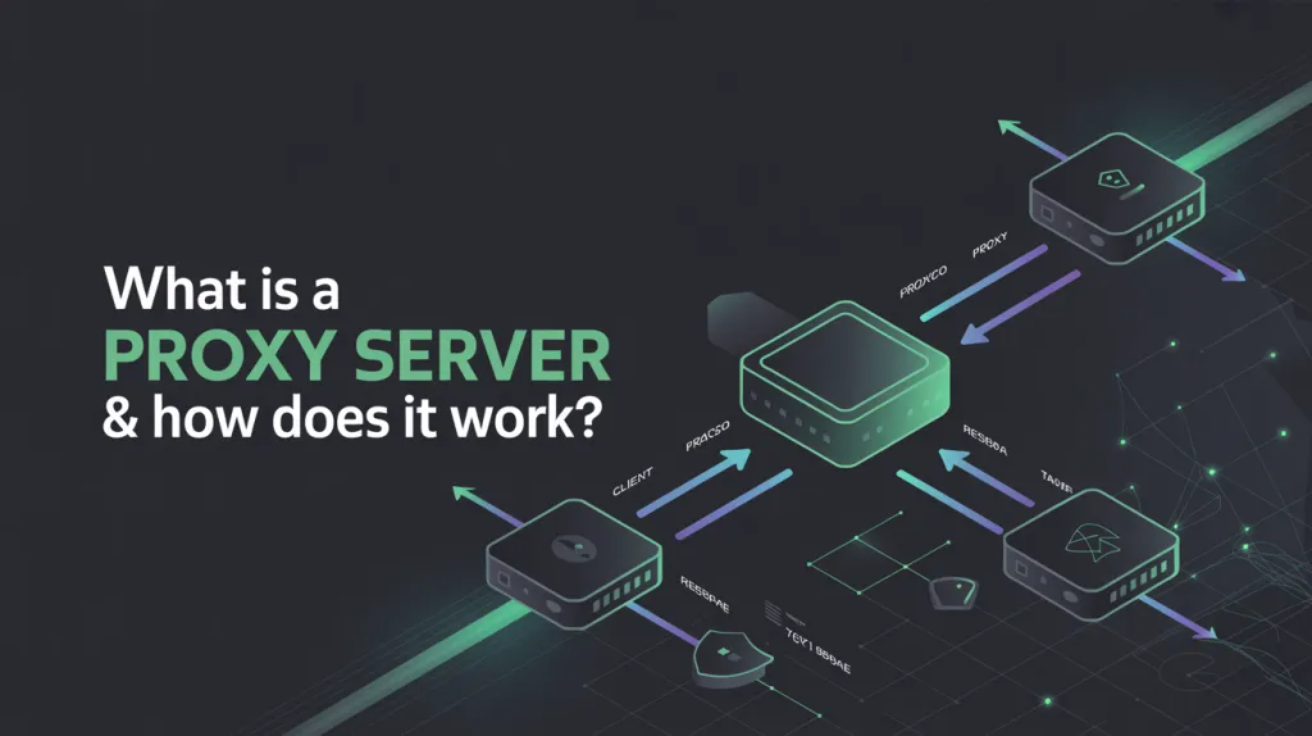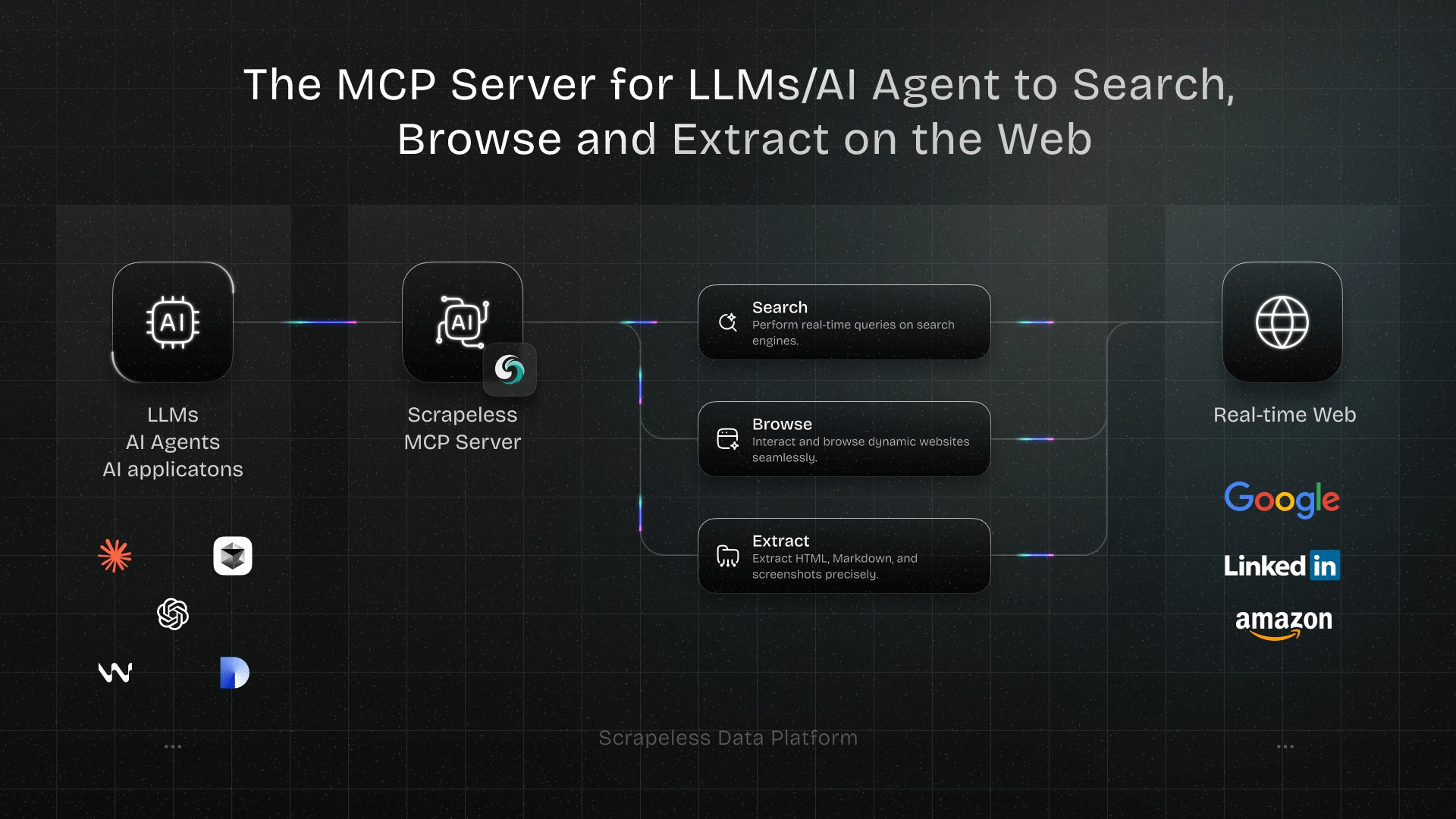What Is a Proxy Server & How Does It Work?
Advanced Data Extraction Specialist
Introduction
A proxy server is a vital intermediary that provides a gateway between users and the internet. It enhances security, protects privacy, and can even improve network performance. This article explains what a proxy server is, how it functions, and explores 10 key solutions and use cases. Whether you are a business owner, a developer, or simply a curious internet user, understanding proxy servers will empower you to make more informed decisions about your online activities.
Key Takeaways
- A proxy server acts as an intermediary between your device and the internet.
- Proxies enhance security by hiding your IP address and filtering malicious traffic.
- They can be used to access geo-restricted content and improve network speed through caching.
- There are various types of proxies, each with specific functionalities and levels of anonymity.
- Scrapeless offers robust proxy solutions for various business needs.
10 Ways to Use a Proxy Server
1. Enhance Security with a Firewall Proxy
A firewall proxy acts as a barrier between your internal network and the internet, filtering incoming and outgoing traffic to block malicious content. This is a fundamental security measure for any organization.
How it works:
The proxy inspects data packets and applies a set of security rules. For example, you can configure it to block traffic from known malicious IP addresses or to prevent certain types of files from being downloaded.
Example Configuration (using a hypothetical proxy command-line interface):
proxy config firewall enable
proxy rule add block src_ip=198.51.100.10
proxy rule add block file_type=exeThis configuration enables the firewall, blocks a specific IP address, and prevents the download of executable files.
2. Access Geo-Restricted Content
Many online services restrict content based on the user's geographical location. A proxy server can make it appear as if you are accessing the internet from a different country, allowing you to bypass these restrictions.
How it works:
You connect to a proxy server located in the desired country. The proxy then forwards your requests to the internet, so the websites you visit see the proxy's IP address, not yours.
Example using Python's requests library:
python
import requests
proxies = {
'http': 'http://user:pass@10.10.1.10:3128',
'https': 'https://user:pass@10.10.1.10:1080',
}
response = requests.get('https://www.example.com', proxies=proxies)
print(response.text)3. Improve Performance with Caching
Proxy servers can cache frequently accessed web pages and files. When a user requests a cached resource, the proxy can deliver it directly, reducing latency and saving bandwidth.
How it works:
The first time a user requests a resource, the proxy fetches it from the internet and stores a copy in its cache. Subsequent requests for the same resource are served from the cache.
Example Configuration (hypothetical):
proxy config cache enable
proxy cache set max_size=10GB
proxy cache set max_age=24hThis configuration enables caching with a maximum size of 10GB and a maximum age of 24 hours for cached objects.
4. Conduct Anonymous Web Scraping
Web scraping is the process of extracting data from websites. Using a proxy server is essential for large-scale scraping to avoid being blocked by websites that limit the number of requests from a single IP address.
How it works:
By rotating through a pool of proxy servers, you can distribute your requests across multiple IP addresses, making it difficult for websites to detect and block your scraping activity.
Example using Python and a list of proxies:
python
import requests
import random
proxies = ['http://proxy1.example.com:8080', 'http://proxy2.example.com:8080', 'http://proxy3.example.com:8080']
def get_with_proxy(url):
proxy = random.choice(proxies)
return requests.get(url, proxies={'http': proxy, 'https': proxy})
response = get_with_proxy('https://www.example.com')
print(response.status_code)5. Secure Your Wi-Fi Connections
Public Wi-Fi networks are often unsecured, making them a prime target for attackers. A proxy server can encrypt your traffic, protecting your data from eavesdroppers.
How it works:
You configure your device to route all its internet traffic through a secure proxy server. The proxy encrypts your data, making it unreadable to anyone on the same network.
Example (conceptual):
- Subscribe to a secure proxy service.
- Follow the provider's instructions to configure the proxy on your device (e.g., in your operating system's network settings).
- All your internet traffic will now be routed through the secure proxy.
6. Monitor and Filter Employee Internet Usage
Businesses often use proxy servers to monitor and control employee internet usage. This helps ensure productivity, prevent access to inappropriate content, and enforce company policies.
How it works:
All employee internet traffic passes through the proxy server, which logs activity and can block access to specific websites or categories of content based on predefined rules.
Example Configuration (conceptual, often managed via a web interface):
- Define categories of websites to block (e.g., social media, adult content, streaming services).
- Create user groups and apply different filtering policies to each group.
- Generate reports on internet usage for auditing and compliance.
7. Bypass Network Restrictions and Censorship
In some regions or organizations, internet access may be restricted or censored. Proxy servers can help users bypass these restrictions by routing traffic through an unrestricted network.
How it works:
By connecting to a proxy server outside the restricted network, users can access content that would otherwise be blocked. This is particularly useful for journalists, researchers, and individuals in areas with strict internet controls.
Example (using a command-line SOCKS proxy client like proxychains):
bash
# Install proxychains (e.g., on Ubuntu: sudo apt-get install proxychains)
# Edit /etc/proxychains.conf to add your proxy server details
# Example: socks5 127.0.0.1 9050
proxychains firefox www.blockedwebsite.comThis command launches Firefox through the configured SOCKS proxy, allowing access to blocked websites.
8. Load Balance Network Traffic
Reverse proxy servers are commonly used for load balancing, distributing incoming network traffic across multiple backend servers. This improves performance, reliability, and scalability of web applications.
How it works:
The reverse proxy receives client requests and intelligently forwards them to one of the available backend servers based on various algorithms (e.g., round-robin, least connections). If a server fails, the reverse proxy can redirect traffic to healthy servers.
Example Configuration (Nginx as a reverse proxy):
nginx
http {
upstream backend_servers {
server backend1.example.com;
server backend2.example.com;
server backend3.example.com;
}
server {
listen 80;
location / {
proxy_pass http://backend_servers;
}
}
}This Nginx configuration sets up a load balancer for three backend servers.
9. Enhance Application Security (WAF Integration)
Proxy servers, especially reverse proxies, can integrate with Web Application Firewalls (WAFs) to provide an additional layer of security for web applications. They protect against common web vulnerabilities like SQL injection and cross-site scripting (XSS).
How it works:
The WAF inspects all incoming requests to the web application, filtering out malicious traffic before it reaches the application server. This protects the application from various attacks and helps maintain data integrity.
Example (conceptual):
- Deploy a WAF in front of your web application.
- Configure the reverse proxy to route all traffic through the WAF.
- The WAF will automatically detect and block known attack patterns.
10. Develop and Test Geo-Specific Applications
Developers often use proxy servers to simulate different geographical locations during the development and testing of applications. This ensures that geo-targeted features and content work correctly for users worldwide.
How it works:
By switching between proxy servers located in different countries, developers can test how their application behaves when accessed from various regions, including content display, language localization, and performance.
Example (using a browser extension for proxy switching):
- Install a proxy switcher extension in your browser (e.g., FoxyProxy).
- Add multiple proxy configurations for different countries.
- Easily switch between proxies to test geo-specific functionalities of your application.
Power Your Data Needs with Scrapeless
For businesses and developers requiring robust and reliable proxy solutions, Scrapeless offers a powerful platform. Whether you need to bypass geo-restrictions, perform large-scale web scraping, or ensure anonymous browsing, Scrapeless provides a comprehensive suite of tools designed to meet your data acquisition needs. Their advanced proxy network ensures high uptime and performance, making it an ideal choice for demanding tasks.
Scrapeless simplifies the complexities of proxy management, allowing you to focus on extracting valuable data without worrying about infrastructure. Their service is built for scalability, offering solutions that adapt to your growing requirements. Explore how Scrapeless can enhance your data operations and streamline your online activities.
Conclusion
Proxy servers are indispensable tools in today's interconnected world, offering a wide array of benefits from enhanced security and privacy to improved network performance and access to geo-restricted content. Understanding the different types of proxy servers and their applications empowers individuals and organizations to navigate the internet more securely and efficiently. From protecting sensitive data on public Wi-Fi to enabling large-scale web scraping, proxy servers play a crucial role in modern digital operations. As the digital landscape continues to evolve, the importance of proxy servers in maintaining online safety and accessibility will only grow.
Ready to Enhance Your Online Operations?
Discover how Scrapeless can revolutionize your data collection and online privacy. Sign up today and experience the power of a reliable proxy network.
Frequently Asked Questions
Q1: What is the primary purpose of a proxy server?
A proxy server primarily acts as an intermediary between a user and the internet, enhancing security, privacy, and performance by filtering requests, masking IP addresses, and caching data.
Q2: How does a proxy server differ from a VPN?
While both proxy servers and VPNs can mask your IP address and bypass geo-restrictions, a VPN encrypts all your network traffic, providing a higher level of security and privacy across your entire device. A proxy typically only handles traffic for a specific application or browser.
Q3: Are free proxy servers safe to use?
Free proxy servers can be risky as they may log your activity, inject ads, or even contain malware. It is generally recommended to use reputable paid proxy services for better security and reliability.
Q4: Can a proxy server improve my internet speed?
Yes, a proxy server can improve internet speed through caching. When you request content that has been previously accessed and stored by the proxy, it can deliver the content much faster than fetching it directly from the original server.
Q5: What are the main types of proxy servers?
The main types include transparent proxies, anonymous proxies, distorting proxies, high anonymity proxies, and reverse proxies, each offering different levels of anonymity and functionality.
References
- Fortinet: What is a Proxy Server? Definition, Uses & More
- Varonis: What is a Proxy Server and How Does it Work?
- PCMag: What Is a Proxy Server and Do You Need One?
- UpGuard: What is a Proxy Server? How They Work + Security Risks
- Okta: Understanding Proxy Servers and How They Work
Recommended Article
- Learn more about Scrapeless Proxies
- Explore the Scrapeless Scraping API
- Discover how Scrapeless can help with Google Search solutions
- Optimize your social media data collection
- Streamline your travel and airline data acquisition
At Scrapeless, we only access publicly available data while strictly complying with applicable laws, regulations, and website privacy policies. The content in this blog is for demonstration purposes only and does not involve any illegal or infringing activities. We make no guarantees and disclaim all liability for the use of information from this blog or third-party links. Before engaging in any scraping activities, consult your legal advisor and review the target website's terms of service or obtain the necessary permissions.



